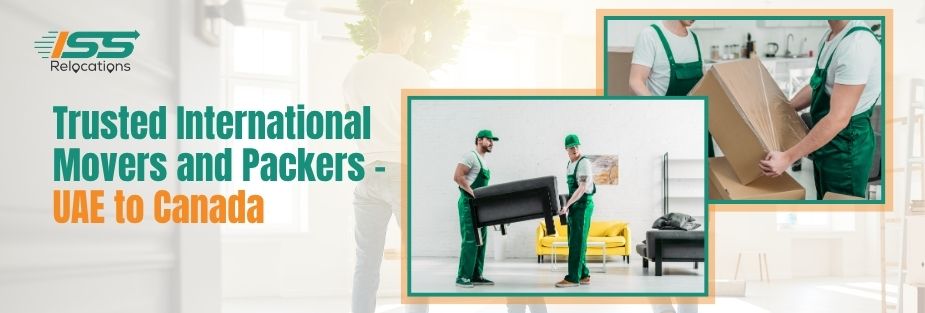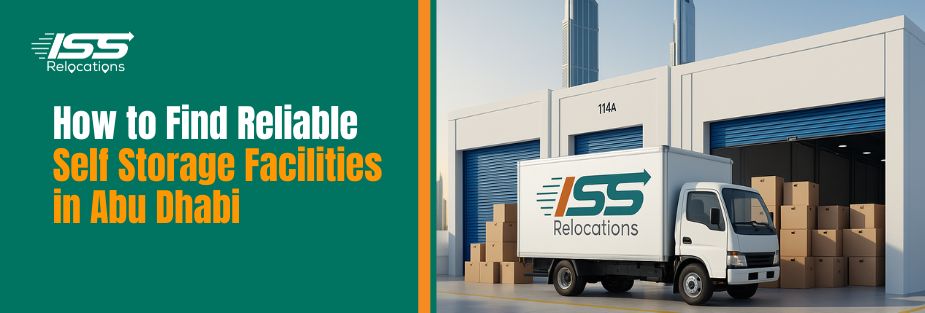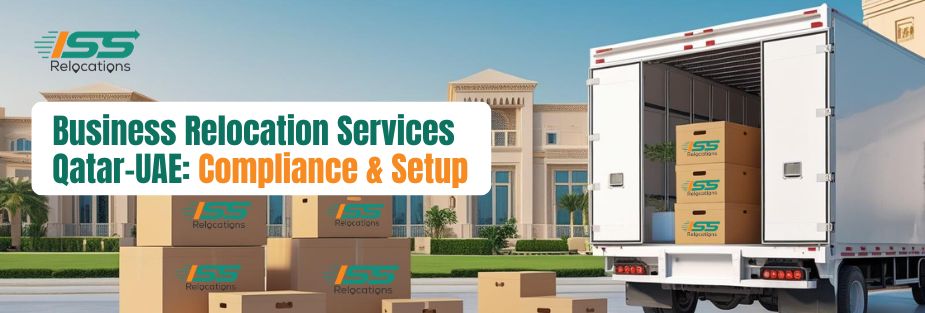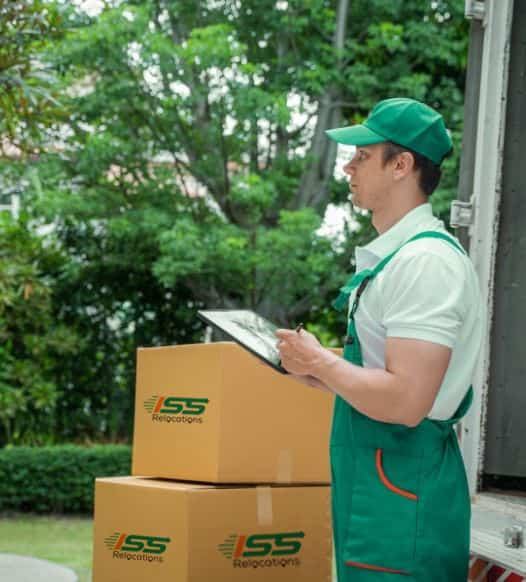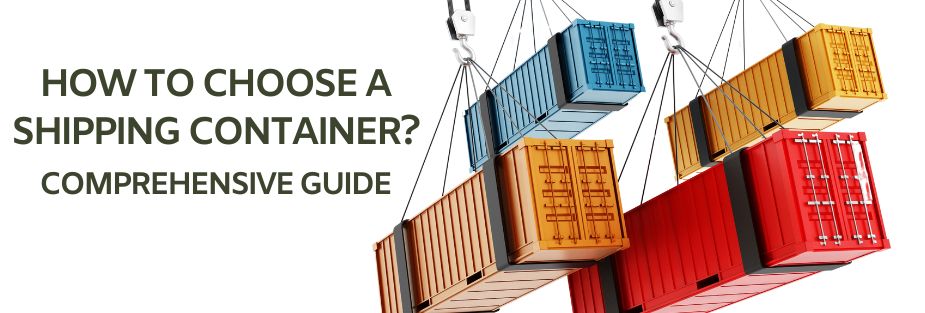
How To Choose A Shipping Container? – Comprehensive Guide
If you are planning to relocate internationally, you need to choose the right shipping container for your international move to be efficient and as convenient as possible. Whether you plan to move all your belongings or just a few things, understanding how to choose a shipping container can make your life a lot easier.
Shipping containers have made international moves a lot more convenient and efficient. However, not all containers serve a common purpose. You must make your choice after considering your requirements and evaluating your options. It requires knowledge and planning.
Don’t worry, we are here to help you with exactly that! Here, we will guide you through all you need to know to choose the right shipping container for your international move. From understanding different types of containers, their benefits to their costs, we will talk about it all.
Understanding Shipping Containers
Shipping containers are more than just big metal boxes; they’re the backbone of international relocation. Here’s a closer look at their history, the various types available, and the concept of shared containers.
The Evolution of Shipping Containers
The idea of using shipping containers to transport goods across the globe was manifested in the 1950s by Malcom McLean. This innovation dramatically changed the logistics world, making shipping quicker, safer, and more economical. The introduction of standard container sizes, primarily the 20-foot and 40-foot versions, introduced the global standardization of shipping. These containers could be used across different modes of transportation worldwide.
Types of Shipping Containers
- Size: The 20-foot container is ideal for smaller shipments or household moves, offering about 1,172 cubic feet of space. For larger homes or more substantial moves, the 40-foot container provides around 2,385 cubic feet of space. High Cube containers, similar to 40-foot containers but with an extra foot of height, are perfect for taller items.
- Material: Containers are typically made of steel or aluminum. Steel containers are praised for their strength and durability, ideal for long-distance moves and harsh weather conditions. Aluminum containers, though lighter and easier to transport, might not offer the same level of protection.
- Condition: New (one-trip) containers are in pristine condition and are best for those needing the highest quality and security. Used containers can be a more budget-friendly option but require thorough inspection to ensure they meet your needs.
Shared Containers and Their Benefits
For those not needing a whole container, shared containers (Less than Container Load, LCL) present a cost-effective solution. This option allows you to pay for only the space you use, making it ideal for smaller moves. Shared containers also offer flexibility, security, and an environmentally friendly way to move internationally, as they maximize the use of space in each shipment.
Understanding these basics about shipping containers can significantly aid in planning your international move, ensuring you choose the right type and size for your needs, while also considering the most cost-effective and secure options available.
How to Choose the Right Shipping Container
Choosing the right shipping container for your international move is crucial. The right choice ensures your belongings travel safely, securely, and affordably. Let’s navigate through the key factors you should consider for making the best decision for your needs.
Assessing Your Needs
- Volume of Goods: Start by estimating how much stuff you need to move. If you’re moving a large household, you might need a 40-foot container, or possibly more than one. For smaller moves or if you’re looking to save money, consider a 20-foot container or a shared container option.
- Special Requirements for Sensitive Items: Consider any special items you’ll be moving, such as artwork, musical instruments, or electronics. These may require temperature-controlled containers or extra padding and support during transit.
Selecting the Container Size
- 20ft vs. 40ft Containers: Your choice between these two sizes should be based on the volume of goods you’re moving. A 20-foot container is sufficient for the contents of a one-to-two-bedroom apartment, while a 40-foot container can accommodate a three-to-five-bedroom house.
- When to Opt for a Shared Container: If your belongings don’t fill up a whole container, a shared container could be a more economical choice. This option allows you to pay only for the space you use, which can significantly reduce shipping costs.
Condition and Quality
- New vs. Used: What to Consider: New (“one-trip”) containers are in excellent condition but are more expensive. Used containers can be a budget-friendly option but inspect them for structural integrity, rust, and cleanliness to avoid potential issues.
- Inspection Tips for Quality Assurance: When possible, inspect the container or have someone inspect it on your behalf. Look for signs of damage, ensure the doors seal properly, and check for any odors or signs of previous cargo that might affect your belongings.
Choosing the right shipping container involves balancing your needs, budget, and the specific requirements of your move. By carefully considering these factors, you can select a container that offers the best protection and value for your international relocation. Remember, the goal is to ensure your belongings arrive at your new home safely and in the same condition as when they left.
Cost Considerations
When planning your international relocation, understanding the costs associated with shipping containers is crucial. These costs can vary widely based on several factors, including the size of the container, whether it’s new or used, the distance of your move, and additional services you might need. Let’s break down the key cost considerations to help you budget for your move effectively.
Understanding the Basic Costs of Shipping Containers
The basic cost of renting or purchasing a shipping container for your move depends on:
- Container Size and Type: A new 20-foot container can cost differently than a 40-foot container. Prices also vary between standard and high cube containers, with high cube containers typically costing more due to the additional space they provide.
- Condition: New (one-trip) containers are more expensive than used ones. The price for used containers will depend on their condition and age.
- Availability and Location: Costs can vary based on local supply and demand. If you’re in a location with a surplus of containers, prices may be lower.
Expecting Additional Costs: Insurance and Shipping Fees
- Shipping Fees: The cost to ship your container internationally will depend on the route, the time of year, and the shipping company. These fees can significantly impact your total moving costs.
- Insurance: Investing in comprehensive insurance for your container and its contents is wise. This protects against damage or loss during transit.
- Customs and Duties: Be prepared for potential customs fees and taxes when your container arrives in the destination country. These costs can vary widely and impact your overall budget.
- Delivery and Handling Fees: Once your container arrives, there may be additional costs for unloading, handling, and transporting it to your new home.
Planning your budget with these costs in mind will help you avoid unexpected expenses and ensure a smoother relocation process. Remember, the cheapest option isn’t always the best. Weighing cost against factors like timing, convenience, and peace of mind is essential for a successful international move.
Find the perfect shipping container!
Contact us now and start planning your hassle-free relocation!
Logistics and Planning
Successfully relocating internationally with a shipping container involves meticulous planning and understanding of the logistics. This phase ensures that your belongings are packed, shipped, and arrive safely at your new home. Let’s navigate through the essential steps for a smooth transition.
Choosing a Reliable Shipping Company
ISS Relocations stands out as a reputable shipping company with extensive experience in international relocations. Whether you require 20ft containers or 40ft containers, you can count on us to provide you with an ideal container solution.
Preparing Your Items for Shipping
Packing and preparing your items for a long journey requires careful consideration. Here are key tips to ensure your belongings are well-protected:
- Packing Materials: Use high-quality, durable packing materials designed for international shipping. Consider professional packing services for fragile or high-value items.
- Inventory: Create a detailed inventory of items you’re shipping. This will be invaluable for insurance purposes and customs clearance.
- Documentation: Ensure you have all necessary documentation, including a detailed packing list, insurance paperwork, and any required customs documents.
Understanding the Timeline and Tracking
- Timeline: Be aware of the shipping timeline, which can vary depending on the destination and time of year. Ask your shipping company for an estimated delivery window and plan accordingly.
- Tracking: Utilize tracking options provided by your shipping company to stay updated on your container’s journey. This allows for peace of mind and helps you prepare for its arrival.
Proper logistics and planning are critical for a stress-free international move. By choosing a reliable shipping company, preparing your items carefully, and understanding the shipping process, you can ensure that your relocation goes as smoothly as possible. Remember, the key to a successful move is in the details, so take the time to organize and plan each step of the way.
Customs and Regulations
Navigating the customs clearance process is a crucial step in your international relocation journey. Each country has its own set of rules and regulations regarding the import of personal goods and household items. Being well-prepared and understanding these requirements can help ensure your shipping container passes through customs smoothly and reaches your new home without unnecessary delays or expenses.
Navigating the Customs Clearance Process
- Research: Start by researching the customs regulations of your destination country. Look for information on prohibited items, taxes, and duties applicable to your belongings.
- Documentation: Proper documentation is critical for a hassle-free customs experience. This typically includes a detailed inventory list (often in English and the destination country’s official language), receipts for new or high-value items, and a copy of your passport. Some countries may require additional documents, such as a visa or work permit, to prove your intent to reside there.
Documents You’ll Need
The most commonly required documents for clearing your shipment through customs include:
- Bill of Lading or Air Waybill: This is the contract between you and the carrier transporting your goods.
- Detailed Inventory List: A comprehensive list of the items being shipped, sometimes requiring specific details like serial numbers for electronics.
- Proof of Residence: Documents proving your residence in the destination country, such as a lease agreement or utility bill.
- Insurance Policy: If applicable, documentation of insurance coverage for your shipment.
Common Pitfalls to Avoid
- Underestimating the Importance of a Detailed Inventory: A vague or incomplete inventory can cause delays and fines. Be precise and thorough.
- Not Checking Prohibited Items: Every country has a list of items that cannot be imported. Check this list beforehand to avoid complications.
- Forgetting About Taxes and Duties: Depending on your status (returning citizen, new resident, etc.), and the items you’re shipping, you may be subject to taxes and duties. Factor these into your budget.
Understanding and preparing for the customs process is essential for a smooth international move. It’s advisable to work with a shipping company experienced in international relocations, as they can provide valuable guidance and support throughout this complex process. With proper preparation and awareness of the regulations, you can look forward to starting your new chapter abroad with minimal stress.
Beyond choosing the right container, it’s important to stay informed about the regulatory environment. Recent industry feedback to the EU on container shipping competition rules highlights ongoing efforts to ensure fair practices in global logistics.
Conclusion
Choosing the right shipping container requires addressing the complexities of an international move and can seem daunting at first. However, with the right guidance, the process can become smoother and less stressful.
In this article, we have tried to help you understand the different types of shipping containers, assessment of your needs, and consideration of the costs, logistics, and customs regulations involved. With these things taken care of, you can make an informed decision that best suits your situation the best.
And for those seeking expert assistance, ISS Relocations offers international moving services that can simplify the process, ensuring your move is handled with precision and care.
Plan Stress-free Move with Top Moving Company in UAE - ISS Relocations

Frequently Asked Questions
How do I choose the right shipping container?
Choosing the right container depends on your shipment size, type of goods, and shipping method. For personal relocations, 20ft or 40ft containers are most common. ISS Relocations provides expert advice to ensure you select the best container for your needs.
What to look for when buying a shipping container?
When buying a container, check for structural integrity, proper seals, and no visible rust or leaks. Consider size, weight capacity, and ventilation needs based on your shipment. ISS Relocations offers guidance to help you make an informed decision.
What are the factors to be considered while choosing a container?
Key factors include container size, condition, security features, and suitability for the type of goods being shipped. ISS Relocations evaluates your requirements and provides tailored solutions, ensuring you choose the perfect container for your shipment.
How to pick up a shipping container?
Picking up a shipping container requires coordination with a port or depot and arranging suitable transport, such as a flatbed truck. ISS Relocations handles logistics for container pickup, ensuring a hassle-free process for your relocation.
What can fit in a 20ft container?
A 20ft container can typically hold the contents of a 2-3 bedroom home or a car with a few additional items. ISS Relocations ensures efficient packing and use of space, maximizing the value of your container.
How much does container shipping cost?
The cost of container shipping depends on size, destination, and additional services. On average, 20ft containers range from $2,000–$5,000, and 40ft containers from $4,000–$10,000. ISS Relocations offers competitive pricing and customized shipping solutions.
How much does a 40-foot container cost?
A 40ft container typically costs $3,500–$6,000 to purchase or $4,000–$10,000 for international shipping, depending on distance and services. ISS Relocations provides detailed cost breakdowns to help you budget effectively.
How many cars can fit in a 40ft container?
A 40ft container can accommodate up to two standard cars or one larger SUV, with additional room for smaller items. ISS Relocations ensures safe and secure loading, offering comprehensive services to meet your container shipping needs.
Moving Company - Recent Blog
Stay informed and prepared for your next move with our latest blogs on moving services in the UAE. From expert packing tips to international relocation guides, ISS Relocations brings you up-to-date insights to make your moving experience smoother, safer, and stress-free.

